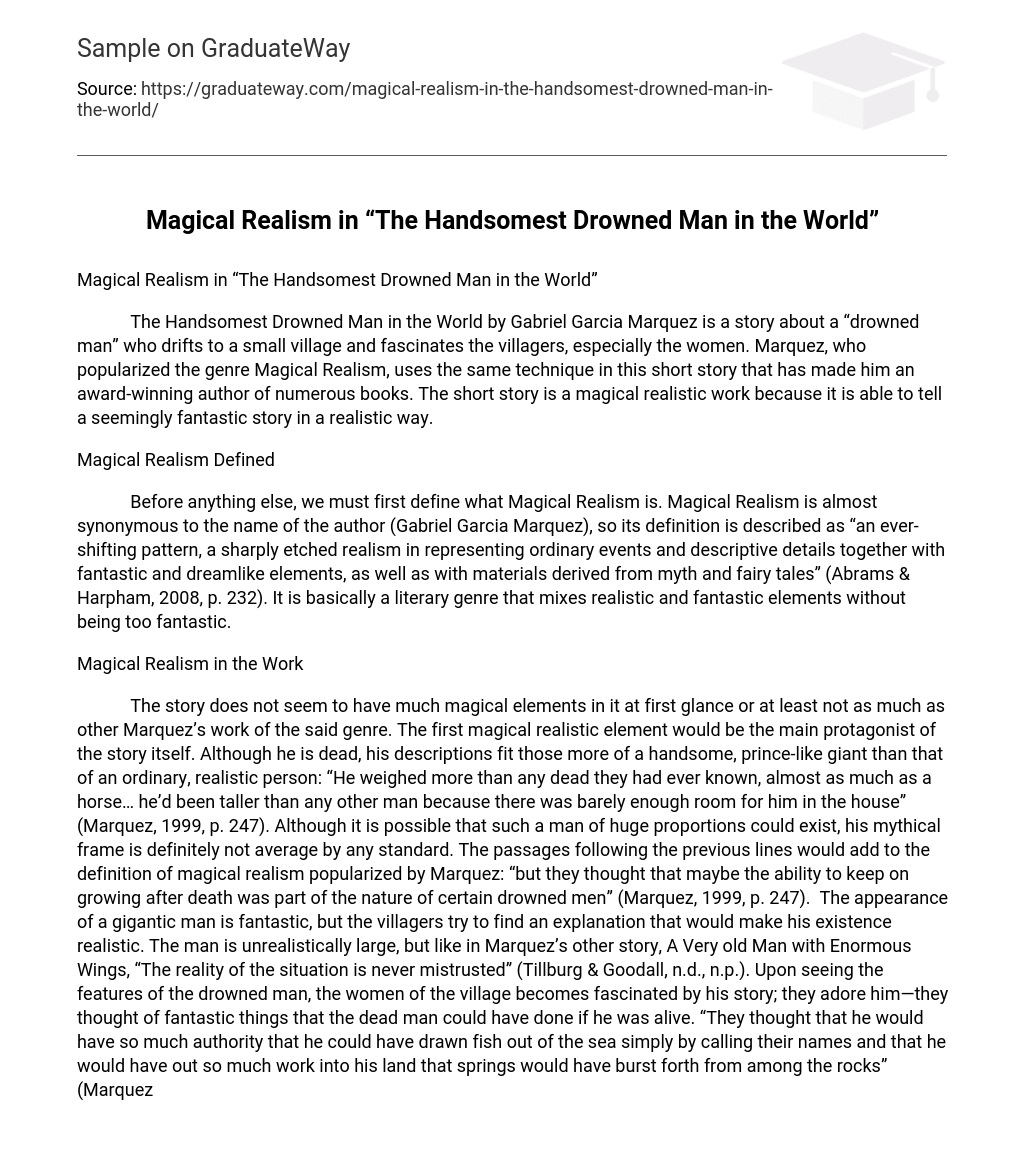The Handsomest Drowned Man in the World by Gabriel Garcia Marquez is a story about a “drowned man” who drifts to a small village and fascinates the villagers, especially the women. Marquez, who popularized the genre Magical Realism, uses the same technique in this short story that has made him an award-winning author of numerous books. The short story is a magical realistic work because it is able to tell a seemingly fantastic story in a realistic way.
Magical Realism Defined
Before anything else, we must first define what Magical Realism is. Magical Realism is almost synonymous to the name of the author (Gabriel Garcia Marquez), so its definition is described as “an ever-shifting pattern, a sharply etched realism in representing ordinary events and descriptive details together with fantastic and dreamlike elements, as well as with materials derived from myth and fairy tales” (Abrams & Harpham, 2008, p. 232). It is basically a literary genre that mixes realistic and fantastic elements without being too fantastic.
Magical Realism in the Work
The story does not seem to have much magical elements in it at first glance or at least not as much as other Marquez’s work of the said genre. The first magical realistic element would be the main protagonist of the story itself. Although he is dead, his descriptions fit those more of a handsome, prince-like giant than that of an ordinary, realistic person: “He weighed more than any dead they had ever known, almost as much as a horse… he’d been taller than any other man because there was barely enough room for him in the house” (Marquez, 1999, p. 247). Although it is possible that such a man of huge proportions could exist, his mythical frame is definitely not average by any standard.
The passages following the previous lines would add to the definition of magical realism popularized by Marquez: “but they thought that maybe the ability to keep on growing after death was part of the nature of certain drowned men” (Marquez, 1999, p. 247). The appearance of a gigantic man is fantastic, but the villagers try to find an explanation that would make his existence realistic. The man is unrealistically large, but like in Marquez’s other story, A Very old Man with Enormous Wings, “The reality of the situation is never mistrusted” (Tillburg & Goodall, n.d., n.p.). Upon seeing the features of the drowned man, the women of the village becomes fascinated by his story; they adore him—they thought of fantastic things that the dead man could have done if he was alive. “They thought that he would have so much authority that he could have drawn fish out of the sea simply by calling their names and that he would have out so much work into his land that springs would have burst forth from among the rocks” (Marquez, 1999, p. 249).
The village itself seemed fantastic: “There was so little land that mothers always went about with the fear that the wind would carry of their children” (Marquez, 1999, p. 248). Again, the likeliness of this event happening is quite bleak, but the author writes it as if it were plain fact that the wind could carry children. This violent weather would change upon the arrival of the handsome drowned man. While the women are sewing a pair of pants that would fit the enormous size of the drowned man, they notice that the wind in the village has calmed since the arrival of the dead stranger. “As they sewed, sitting in a circle and gazing at the corpse between stitches, it seemed to them that the wind had never been so steady nor the seas so restless as on that night and they supposed that the change had something do with the dead man” (Marquez, 1999, p. 249). The sympathy that the drowned man creates in the village is also magical realism. Women wonder that the life of the drowned man could have been terrible because of the troubles created by his size. The women even try to delay the funeral of the drowned man, as if they want to keep him.
The Handsome Drowned Man is magical realistic work not only because it is written by arguably the most popular magical realists but also because it is really a magical realistic type of work. The plot consists of fantastic elements written in a realistic way.
References
- Abrams, M. H. & Harpham, G. G. (2008). A Glossary of Literary Terms (9th Edition).
- Boston, MA: Wadsworth Cengage Learning.
- Marquez, G. (1999). The handsomest drowned man in the world. Collected Stories (Gregory
- Rabassa & J. S. Bernstein, Trans., pp. 247–254). New York, NY: Perennial Classics.
- Van Tillburg, E. & Goodall, K. (2009, January 27). Gabriel Garcia Marquez and magical
- realism. Nebraska Center for Writers. Retrieved February 22, 2009
- http://mockingbird.creighton.edu/NCW/marquez.htm.





